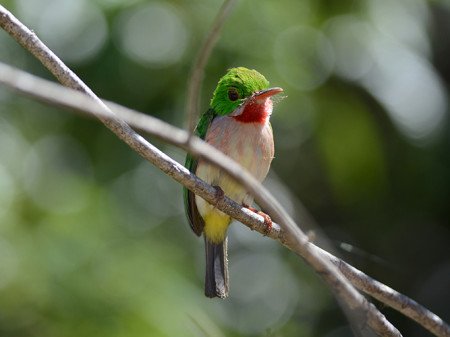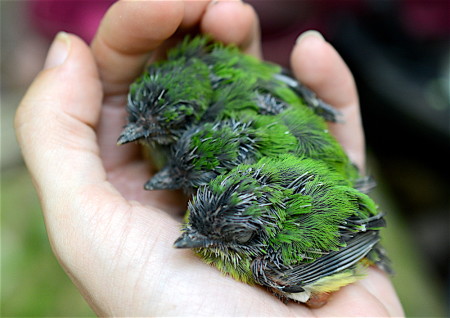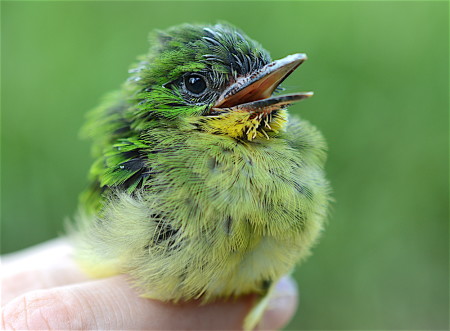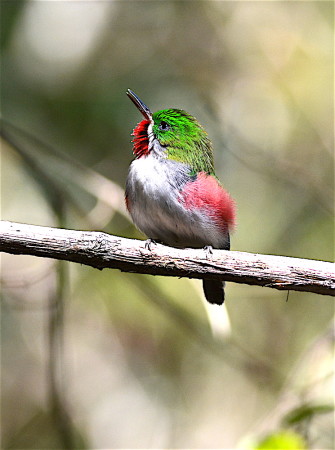
Invasive mammals are known to be a problem on many islands. Holly Garrod shows first-hand how some of these pesky species are causing nest failure for one of the Caribbean’s most well known and best loved birds—the tody.
It was a muggy afternoon, typical for the summers in Jarabacoa, the central region of the Dominican Republic. Rubber boots on and camera in hand I was making my way through the creek system of a local farm. The goal was to check Broad-billed Tody nests. I was in the first field season for my master’s research, studying the breeding biology and behavioral interactions of Hispaniola’s two tody species: the Broad-billed Tody (Todus subulatus) and the Narrow-billed Tody (Todus angustirostris). One aspect of my research included how non-native mammals were affecting their breeding success. I had dubbed the creek I walked through as “tody neighborhood” (or barrio de barrancolis in Spanish), due to the high volume of nests I had found, totaling up to 15 in that one creek alone. I anticipated it would be one of my most productive sites this year, little did I know I was to be wrong.
But before I get into the mystery at tody neighborhood, let me explain some basic tody facts. Todies, while appearing to look like our pollinating hummingbird friends, are actually more closely related to kingfishers. Interestingly enough, todies are one of only two families of birds that are endemic to the Caribbean (the other being Dominican Republic’s national bird – the Palmchat). Within their Family Todidae, there are 5 species distributed throughout the islands of the Greater Antilles, most of which are named for the island they’re found on, excepting the aforementioned Hispaniolan todies. This interesting phenomenon, where Hispaniola is the only island to have two tody species, is the baseline for my master’s research, and the reason I was walking through creeks searching and monitoring for tody nests.

Now when most people hear “bird nest,” they think of an assemblage of twigs and moss carefully placed among the branches. But todies are different. For their nests, the pair chooses a dirt bank, then takes turns digging a burrow using their beaks. Typically, the burrows end up being about 10-15 cm deep, with some of them curving and all of them having an enlarged chamber at the end. With their preference for dirt banks, the best place to look for these burrows ends up being creeks.
Which brings us back to tody neighborhood. Walking through the creeks, notebook in hand, I stopped at the first nest. It was still early in the season, late May, and from my last check I knew all the nests had eggs. Now it was just a matter of seeing when they would hatch. I used an endoscope camera to check the nests, a long bendable tube with a camera and light on one end, where the other end hooked up to a monitor, providing live-stream tody footage. I slid the camera into the first nest, seeing nothing. Knowing that this nest had a tricky curve, I tried for several more minutes until something appeared, a cricket. Oftentimes when the todies finish breeding, other animals will move into the unoccupied cavities; typically large cave crickets are the most common. For this reason, todies almost always construct a new burrow every year. Presence of the cricket meant the nest had failed.
I continued to the other nests, hoping to have better luck. I breathed a sigh of relief as I saw the next nest still had the three eggs noted from several days earlier. But that’s where my luck ended. The next 5 nests had failed. I was baffled, from all outward appearances the nests appeared fine: the holes were still the same size and there were no signs of forced entry or tracks around the banks. When I returned several days later, it was more bad news. More failed nests and still mostly no signs of the culprits. Several nests appeared as though they may have been enlarged, but most others maintained the same outward appearance. Who could be predating these tody nests?

I started putting up camera traps (part of my funding from the David Lee Grant), hoping to get footage of what was happening at these nests. The idea being, the camera traps are motion activated and start recording with the presence of movement. I set one up at one of the few remaining active nests in tody neighborhood, scattering the others at nests in other creeks. One week later, I returned to glean the videos. Sitting back at the field house, going through the videos I was disappointed with the first two cameras. Most of the videos showed twigs moving or people walking by, the angle looking slightly off to catch the curprit.
Then I came to a night picture. I was about to pass by when I saw the outline of a cat walking by. Suspect number 1. Yet when I checked the records that nest had fledged successfully when I retrieved the camera. Plus a cat would have to have caused some external damage to the nest hole to access the tody. Ruled out as the common culprit, but still a potential predator.
The next set of videos I pulled up began with a night shot. I waited several seconds and then suspect number 2 appeared: a rat. I watched several videos of what I can only assume to be the same rat climbing on logs and scurrying around. Video after video I watched the rat run around, but appear oblivious to the nest entrance. Finally, watching the rat take its usual stroll around the log, I saw it. The flicker of interest in the nearby nest hole. I watched as the rat approached, holding my breath. There was no way the rat could fit, it would have to dig out the nest at least a little bit, leave some trace of evidence behind. But lo and behold, the mammal contracted in its side and squeezed into the hole, no damage and no evidence. Then out it came, baby tody in its mouth. I finally understood why the nests were failing!
Video: During the night, a rat enters the tody cavity and predates one of the two tody chicks inside. The other was presumably trampled based on appearance the next day. This rat was caught on camera for several nights before entering the cavity. (Video by Holly Garrod)
As I continued watching the videos for another nest that had failed, I saw a third culprit appear, one I was surprised I hadn’t seen earlier. Let me introduce you to culprit number three, the mongoose. I watched as the weasel-like mammal appeared and begin excitedly digging at the base of the hole until it managed to disappear inside, and return with a single tody chick in its mouth.
Video: A mongoose digs out the nest from below and enters from the bottom, leaving with a tody chick at the end of the video. No todies were present after checking, suggesting the mongoose likely returned for the second chick. (Video by Holly Garrod)

Mystery solved. Or is it? From the videos and what evidence I could find, it appears that rats are the most wanted, followed by mongoose, and leaving room for both feral cats and dogs. What is clear is that the majority of these predations are from introduced mammals. Even though these mammals have likely been present on the island for several hundred years, it may not have been enough time for the tody to adapt in some way. Throughout these videos I saw no evidence of nest defense behavior, or evidence the parents were even present. Additional behavioral experiments I conducted using a mammal decoy showed the same result—no interest or concern in the “mammal” present at the nest. Do we really know the impact these non-native mammals are having on bird populations? Out of 42 Broad-billed Tody nests I was monitoring, nearly half (20) of them failed, while 6 of 20 Narrow-billed Tody nests failed. All of them appeared to fail from non-native mammalian predators.
While these mammals may not be putting a huge dent on the tody populations, it’s clear they are having an impact. Continued predation could cause a decline in population sizes, especially since the todies show little to no defensive behavior and are therefore highly vulnerable. My research highlights the importance of understanding breeding ecology and the factors that influence nest success in Caribbean endemics like the tody. It’s important to monitor populations so that we can undertake management actions if needed to ensure long-term survival of these amazing birds.
By Holly Garrod. Holly is a MsC student in the Biology Dept at Villanova University, Villanova, Pennsylvania. One of the goals of her thesis research in the Dominican Republic is to better understand how Caribbean endemic birds respond to changing landscapes and invasive predators. Holly was a recipient of the 2016-2017 BirdsCaribbean David S. Lee Fund Grant.

It’s time for “management activity”. What’s the plan to get rid of the rats, mongoose, feral cats?
HI Ann, good suggestion, it would be challenging, albeit impossible, to get rid of these harmful invasives, but their numbers could possibly be managed. This would be a big job though! I am guessing that Holly will be making recommendations when she completes her research and we will follow up then. Thanks for writing and we’ll keep you posted.